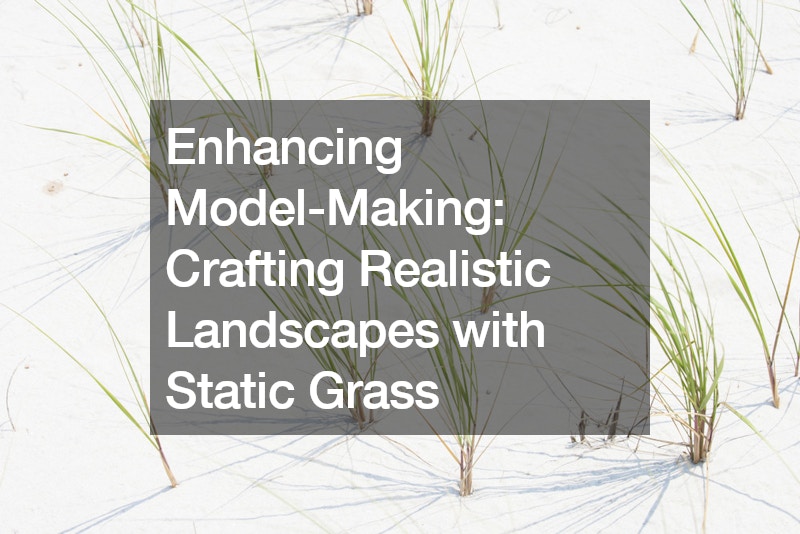Model-making enthusiasts often seek to bring their creations to life with realistic scenery. One key element in achieving this realism is the use of static grass. This tutorial will guide you through the process of utilizing static grass to create lifelike landscapes for your models.
Static grass comes in various lengths, ranging from .5 millimeters to 12 millimeters.
Each length serves a specific purpose in adding depth and texture to your scenery. For basing, a 2-millimeter static grass is commonly used as it provides a solid foundation for further detailing.
To begin, it’s essential to gather the necessary materials for the static grass application system. This includes static grass, a static grass glue, a spreader or brush for applying the glue, and a static grass applicator. The applicator is a vital tool in ensuring an even distribution of grass onto the model’s surface.
First, apply the static grass glue to the desired areas of your model where you want the grass to adhere. Use a spreader or brush to evenly spread the glue, ensuring complete coverage.
Next, load the static grass applicator with the 2-millimeter static grass. Turn on the applicator and attach the crocodile clip to the model’s surface near the glued area. This allows the static charge to attract the grass fibers, creating a realistic carpet effect on the model.
As you apply the grass, aim to cover as much of the glued area as possible to create a uniform appearance. The static grass application system makes this process efficient and straightforward, resulting in a professional-looking finish.
Once the base layer of grass is applied, it’s time to add depth and detail to your scenery. This can be achieved by layering different lengths and colors of static grass. For instance, adding 4-millimeter and 6-millimeter detailing grass in various shades can mimic the natural variations found in grassy landscapes.
The layering process involves spraying the glued area with a layering spray to ensure the new grass adheres properly. Then, using the static grass applicator, apply the additional grass lengths strategically to create depth and texture.
Experiment with different colors and heights to achieve a realistic and visually appealing result. By varying the placement of the grass fibers, you can create a sense of dimensionality in your scenery, making it more lifelike.
Furthermore, don’t be afraid to mix and match grass lengths and colors to achieve the desired effect. Combining shorter and longer grass fibers can add complexity to your scenery, making it more visually interesting.
Remember to allow the glue to dry completely before handling or moving the model to prevent any disruption to the grass fibers. Once dry, your model will showcase a vibrant and realistic landscape, ready to be displayed or incorporated into your larger model-making projects.
In addition to the basic techniques outlined above, there are several advanced tips and tricks you can employ to further enhance your static grass scenery:
- Blending: To create a seamless transition between different grass lengths and colors, blend them together using a dry brush or by gently tapping the surface with your fingers.
- Weathering: Add realism to your scenery by weathering the grass with paints or pastel powders. This can simulate the effects of sun, wind, and moisture on the landscape.
- Texture: Experiment with different textures by mixing static grass with other materials such as flocking, sawdust, or even real earth to add depth and variety to your scenery.
- Detailing: Pay attention to small details such as weeds, flowers, and rocks to further enhance the realism of your model. These can be added using tweezers and glue in strategic locations.
- Seasonal Variation: Consider the season and environment you are modeling when choosing grass colors and lengths. For example, shorter, drier grass may be more suitable for a summer landscape, while longer, browner grass can represent autumn or winter.
- Scale and Proportion: Keep in mind the scale of your model when applying static grass. Avoid using grass fibers that are too long or too thick for the scale of your model, as this can detract from the realism of the scenery.
By incorporating these advanced techniques into your static grass scenery, you can take your model-making skills to the next level and create breathtaking landscapes that captivate the imagination.
In conclusion, static grass is a versatile and essential tool for creating realistic scenery in model-making. By following this tutorial and utilizing a static grass application system, you can achieve lifelike landscapes that enhance the overall aesthetic of your models. Experiment with different lengths, colors, and techniques to bring your creations to life like never before.
.


